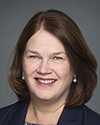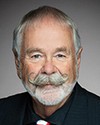Mr. Speaker, I am very pleased to rise today to speak to Bill C-91, an act respecting Indigenous languages.
As all members in the House know, indigenous issues are among the biggest challenges and the biggest opportunities facing our country. As we create together the space for indigenous peoples to be fully self-determining, with an improved quality of life, we must all work together, across party lines, in a non-partisan fashion.
It is in that spirit that I would like to thank the member of Parliament for Kamloops—Thompson—Cariboo for offering me this opportunity to speak as an independent member of Parliament on this important legislation.
The preamble, though not the body of Bill C-91, notes that:
the Government of Canada is committed to implementing the United Nations Declaration on the Rights of Indigenous Peoples, which affirms rights related to Indigenous languages.
Specifically, I would like to remind colleagues that article 13 speaks to the fact that:
Indigenous peoples have the right to revitalize, use, develop and transmit to future generations their histories, languages, oral traditions, philosophies, writing systems and literatures, and to designate and retain their own names for communities, places and persons.
Article 14 goes on to talk about the fact that:
Indigenous peoples have the right to establish and control their educational systems and institutions providing education in their own languages, in a manner appropriate to their cultural methods of teaching and learning....
States shall, in conjunction with indigenous peoples, take effective measures, in order for indigenous individuals, particularly children, including those living outside their communities, to have access, when possible, to an education in their own culture and provided in their own language.
Bill C-91 takes the very important step to establish an office for the commissioner of indigenous languages.
I want to use the time given to me today to highlight some amazing initiatives across the country by indigenous peoples for indigenous peoples to promote indigenous languages.
I had the privilege of visiting many communities when I was minister of indigenous services, as well as when I was minister of health, and I want to share some of the wonderful initiatives I have witnessed.
Let us start in British Columbia.
In British Columbia, it is estimated that there are approximately 30 different first nations languages, and close to 60 dialects are spoken. We cannot speak about first nations languages without remembering Kukpi7 Ron Ignace. Kukpi7 is the name for chief in the Secwepemc language of British Columbia. Kukpi7 Ron Ignace is certainly one of the champions of indigenous languages in his first nation in British Columbia.
Together with his wife, Marianne Ignace, who is a professor at Simon Fraser University, they have written an extraordinary book. This is a book that has been worked on for a lifetime. It is called Secwépemc People, Land, and Laws.
I had the opportunity to visit the community of Skeetchestn, where Kukpi7 Ignace is the chief. I heard the children signing and sharing together in their language, and it was inspiring.
Let me tell the story of Huu-ay-aht First Nations in British Columbia. It is among the Nuu-chah-nulth-speaking first nations. The Huu-ay-aht people have taken an incredible initiative as they continue to pursue and inspire others by their efforts to be fully self-determining. They have established a social services project that takes on a number of initiatives, particularly for children. They have decided to exercise their right to take on child and family services within the Huu-ay-aht First Nations, and they are specifically ensuring they do so in order to bring their children back to their community so they are raised in their language and culture.
Let us move a little east to the province Alberta.
I want to tell my colleagues about the incredible work that is being done in Maskwacis, a region just outside of Edmonton. I had the privilege of being in this community when it announced the beginning of the Maskwacis Education Schools Commission.
I was there with Grand Chief Willie Littlechild, who used to sit in this very House. He spoke about the incredible initiative that the Maskwacîs peoples had been able to undertake in order to start a school system of their own.
Grand Chief Willie Littlechild had been raised in residential schools. He talked about how his language and his culture had been taken from him as he was taken away to one of the largest residential schools in our country. However, now the Maskwacis, which is a gathering of four Indian Act bands, have come together to start a schools commission in order to exercise self-determination. Their education system there is Cree based, based upon the language of their people and their way of teaching. The contents of their teaching are based in their Cree culture and in their language.
We will then go a little further east again to the lovely province of Saskatchewan. Many examples can be seen across Saskatchewan, but perhaps one of the highlights in my mind is when I had the privilege of visiting the Whitecap Dakota First Nation, an extraordinary community just outside the city of Saskatoon.
While I was there, the chief showed me many things, but one of the most impressive was when we went to visit the Charles Red Hawk Elementary School. I met the woman who was the language teacher in that school. She gives Dakota language lessons to the children there. Their proudest moment was when a small group of children stood up spontaneously and asked me if they could sing O Canada to me in the Dakota language. It was a moment that is indelibly impressed on my mind. I saw the pride, not only of the children but of the elder who had taught them their language.
I want to then move to the wonderful province of Manitoba. I have spoken in the House before about the things that I have learned from the first nations of Manitoba as well as the Métis nation of Manitoba.
However, today I want to share a conversation about the work of the Assembly of Manitoba Chiefs. The chiefs have been real leaders in one of the critical issues in our country, and that is the overrepresentation of indigenous children in care. They have highlighted the link between children being taken from their community into the foster care system and the loss of language that accompanies that. In fact, they have gone so far as to propose an act. It is called, the “bringing our children home act”.
In that act, the Manitoba chiefs speak to the fact that “We are reclaiming, practising and promoting our responsibility to pass down our knowledge, language, culture, identity, values, traditions, and customs to our children.”
This morning I had the opportunity to be in the indigenous affairs committee. A gentleman there had been in Manitoba and had experienced the foster care system. His name is Jeffry Nilles. I encourage people to look at the tape of his testimony in today's committee. He talked about what it meant to have been taken from his community, away from his family, about how he was shamed if he spoke in his language. It brought tears to our eyes as we heard about the moments he was treated cruelly because he naturally went to his native language and was punished for doing so. Now he is a man who is proud of the language of his peoples, but it has taken him some time to get there.
I will move further east again to the northern part of the province of Ontario. I would like to highlight in particular the extraordinary community of Fort Albany First Nation. I want to highlight a gentleman there who has been a real inspiration to me. His name is Edmund Metatawabin. Perhaps many members have had the opportunity to meet Edmund.
Edmund wrote a wonderful book, Up Ghost River, which had a big impact on my life. He talks about the role of residential schools. In fact, his book is an account of his residential school experience. He talks about the trauma of being separated from his language and his lineage, when he was forbidden to speak his language. He talks about the disastrous results that have ensued because languages and customs were suppressed by residential schools.
There is a good hint about the importance of indigenous languages in his book. Perhaps the most profound sentences in that book are when Edmund Metatawabin says, “There is no concept of justice in Cree culture. The nearest word is kintohpatatin.” He says that this “loosely translates to 'you've been listened to.'” Metatawabin writes, “Kintohpatatin is richer than justice—really it means you've been listened to by someone compassionate and fair, and your needs will be taken seriously.”
That is a word I will never forget. It reminds me of the richness of a word and how much a particular culture can teach us just by showing us the words of its language, as well as how much that can mean to all of us.
Let me continue to travel across Ontario. This time we will come right down to the border of Ontario and Quebec, and in fact this community crosses into the United States as well. It is the community of Akwesasne. The community has an amazing leader in Grand Chief Abram Benedict. Here again I saw how language is so much a part of the pride of this community.
I had the opportunity to visit for the first time the Mohawk immersion school there. This is a school in which elders have come together to teach the young people, who are the teachers. In turn, those teachers teach the children. People in that middle age group did not know their Mohawk language and had to learn it from the elders. Now they, as teachers, are passing it on to children.
One of the things that impressed me at that school was that they had created their own teaching materials. They had taken children's books and adapted them so that the words were Mohawk. It was not just the words; the concepts, pictures, traditions and stories were appropriate for the Mohawk community. It is an extraordinary example, and one that needs to be recognized.
And now we travel to la belle province. Quebec is home to many first nations, but I am going to talk about just one of them, the Huron-Wendat Nation. Their leader, Grand Chief Konrad H. Sioui, is an extraordinary man.
Konrad Sioui left quite an impression on me. He has many stories to share and knows much about his people's history and their places. He told me how those peoples named places, rivers and mountains. Where he lives, every place has a name in his language.
Across the country, many places have names that come from indigenous languages. Grand Chief Sioui talked about the importance of preserving those names in indigenous languages.
We know, for example, that the word Toronto comes from an indigenous language. It is believed that it comes primarily from a Mohawk name, tkaranto, which means “trees standing in the water”. Right here in the city of Ottawa, we know that the word Ottawa comes from the word adaawe from the Anishinabe language, which means “to buy”. Maybe we could sometimes think about the fact that our city has something to do with buying, but I will not spend too much time on that point.
Let us move along to some places in Quebec, since I was just discussing Quebec. Shawinigan is an Algonquin word that means “portage at the crest”. We then look at the northern part of Quebec, because we must not forget the north, where we find the amazing town of Kuujjuaq, which means “the great river” in Inuktitut.
We had better spend a bit of time in the Atlantic, although I know my time is running out. I want to talk about the incredible work of the Mi'kmaq in the Atlantic, and in particular their incredible education authority. The education authority is entirely led by the Mi'kmaq people and is called Mi'kmaw Kina'matnewey. I think the Mi'kmaq will forgive me for not getting that exactly right. I tried. We have often affectionately called this group “MK” because it is a little easier to say.
This is an education authority designed by Mi'kmaq for Mi'kmaq children. It has been incredibly successful, and this is in no small part related to its commitment to the Mi'kmaq language. It has, in fact, created an online talking dictionary, so that people can now find Mi’kmaq words online. There are now 6,000 or more Mi'kmaq words in this online talking dictionary. It offers language classes using the Internet, and video conference facilities have been set up so day cares throughout the region can teach Mi'kmaq to their children.
I was happy to hear that St. Francis Xavier University has now delivered its first program in the Mi'kmaq language.
While we are in the Atlantic, let us move north to Labrador and talk about Nunatsiavut, which is one of the four land claim regions of the Inuit Nunangat. The commitment of Inuit leaders in this country to the revitalization, maintenance and promotion of Inuktitut is something extraordinary. Inuit speak regularly about how Inuktitut is at the core of Inuit identity, spiritual beliefs and relationships to the land, as well as their world view and culture. It is fundamental to Inuit self-determination. I witnessed this myself when I went to meetings of the Inuit-Crown Partnership Committee, which are all translated into Inuktitut.
However, I should note that the Inuit do not support Bill C-91, and it is important for us to recognize that. The Inuit Tapiriit Kanatami organization, the ITK, hopes to see the bill amended to include both an annex that addresses Inuktitut as a distinct language and provisions allowing Inuktitut speakers to access federal public services in their language.
There is an impact when those services are not available. I saw it myself in relation to health. People said that tuberculosis, for instance, was not recognized quickly enough because there was no health care provider who spoke Inuktitut and could take a proper patient history. This is an important reality.
Time does not permit me to tell members about the things I observed in wonderful places like the Northwest Territories and Yukon. There are many examples of people working to revive indigenous languages.
It is my intention to support the bill, but more work needs to be done on this issue. This work should be continued in the next Parliament by those who have the privilege of returning to this place.
I had the privilege of learning an indigenous language when I lived in the country of Niger, in west Africa. I became moderately fluent in the Hausa language. The Hausa people have a saying:
[Member spoke in Hausa]
[English]
This means “silence, too, is speech”. Let us not, any of us, be silent on this matter, on the need to revitalize, maintain and promote indigenous languages. Let us recall that the United Nations Declaration on the Rights of Indigenous Peoples lays out minimum standards for the survival, well-being and dignity of indigenous peoples.
The right to use, develop and transmit indigenous languages to future generations is nothing less than a matter of survival. The duty to recognize and affirm this right rests on us all.









